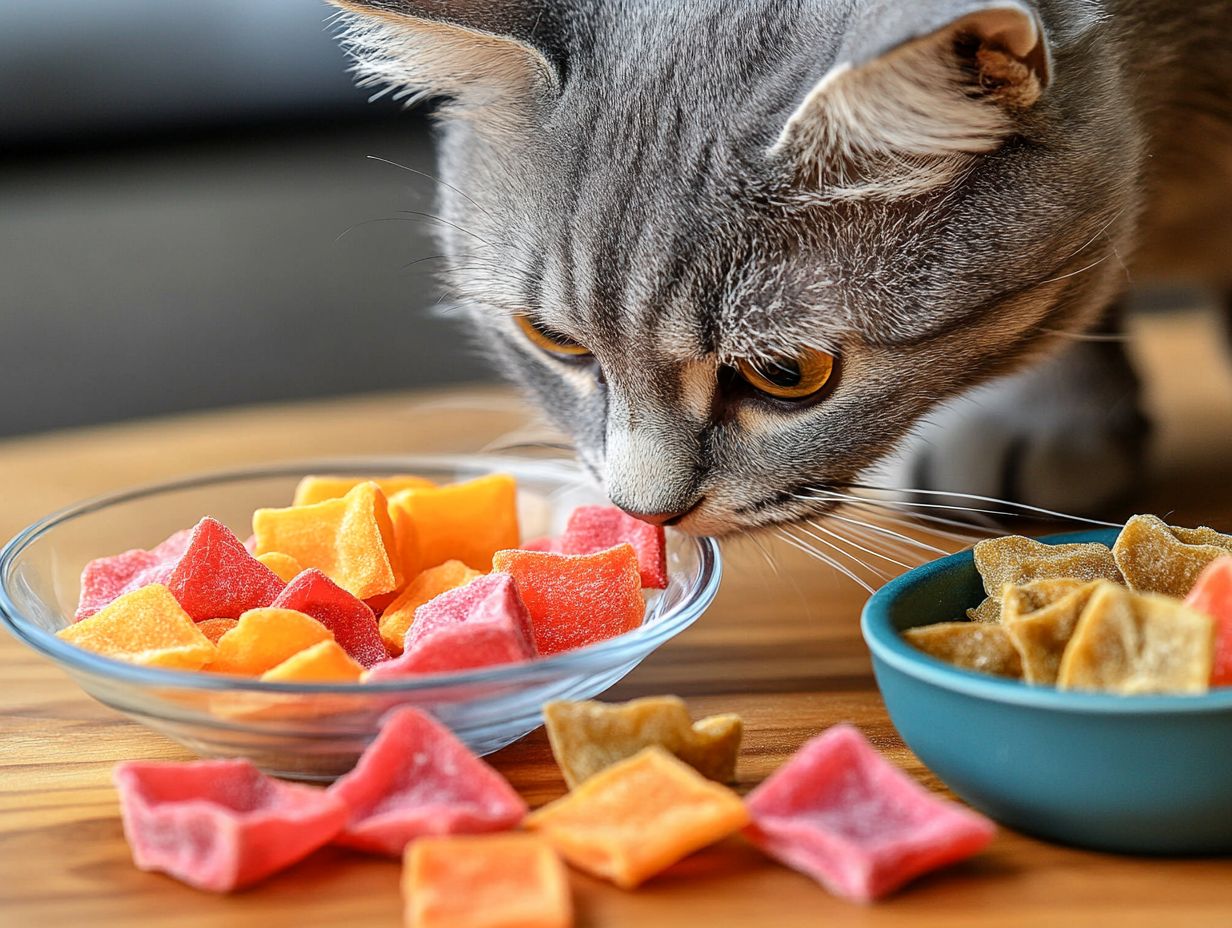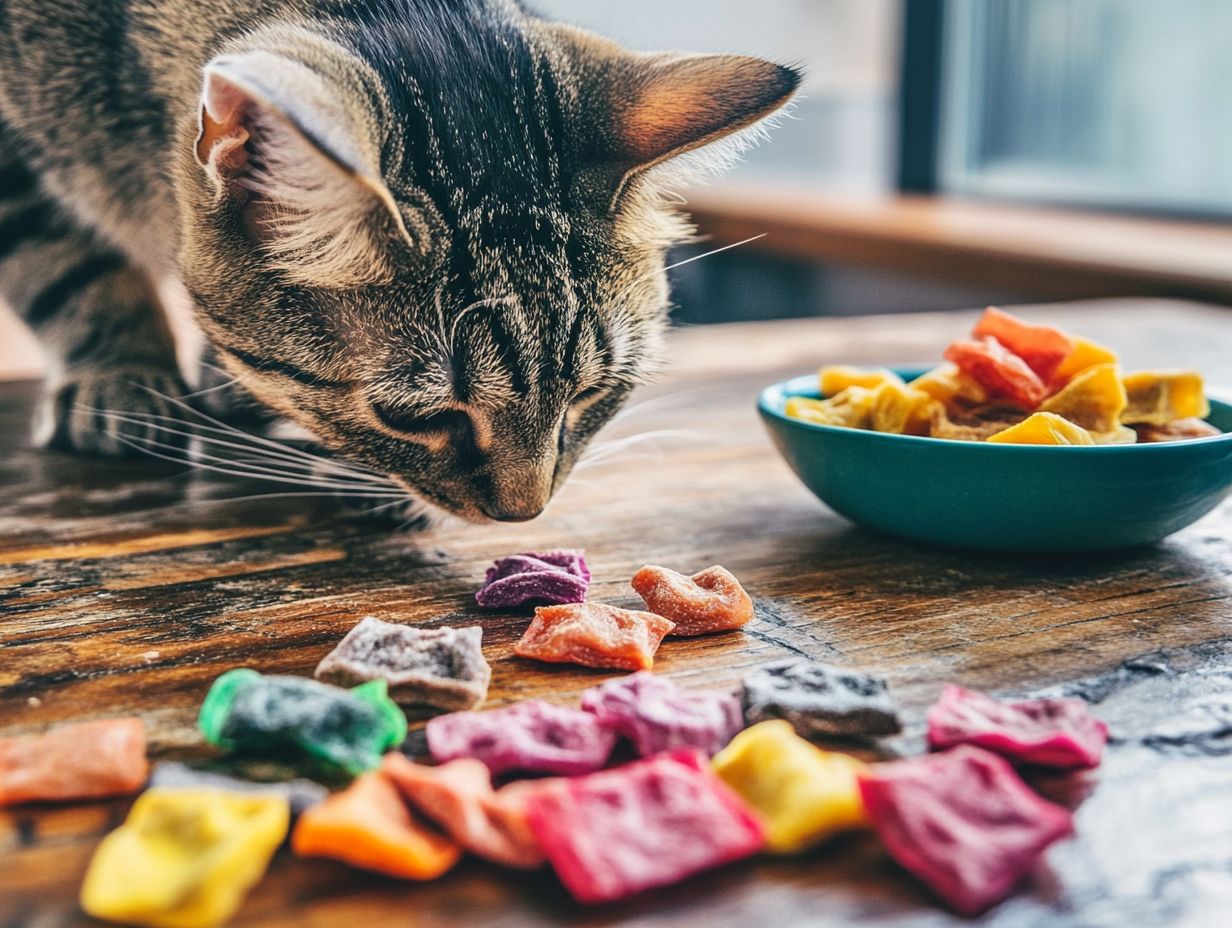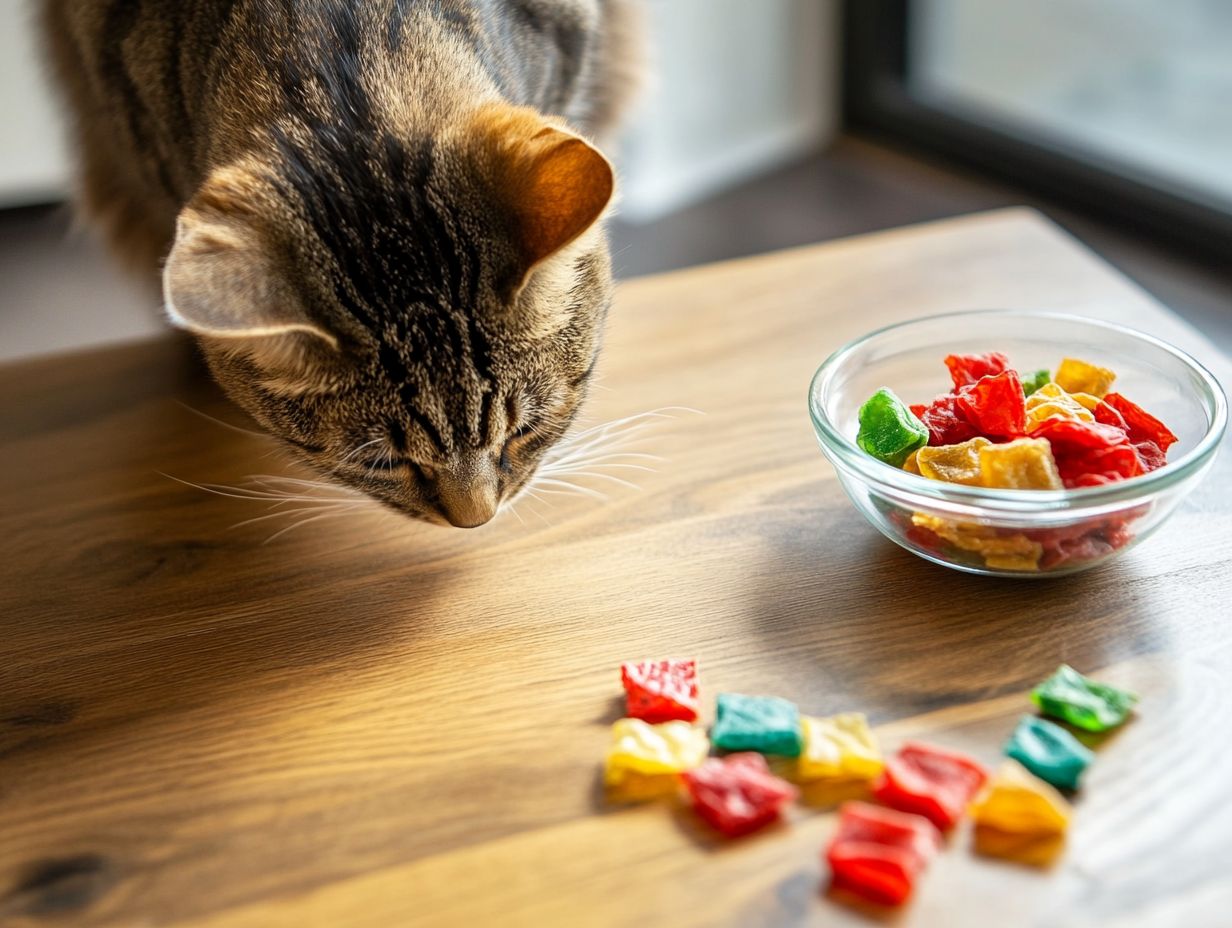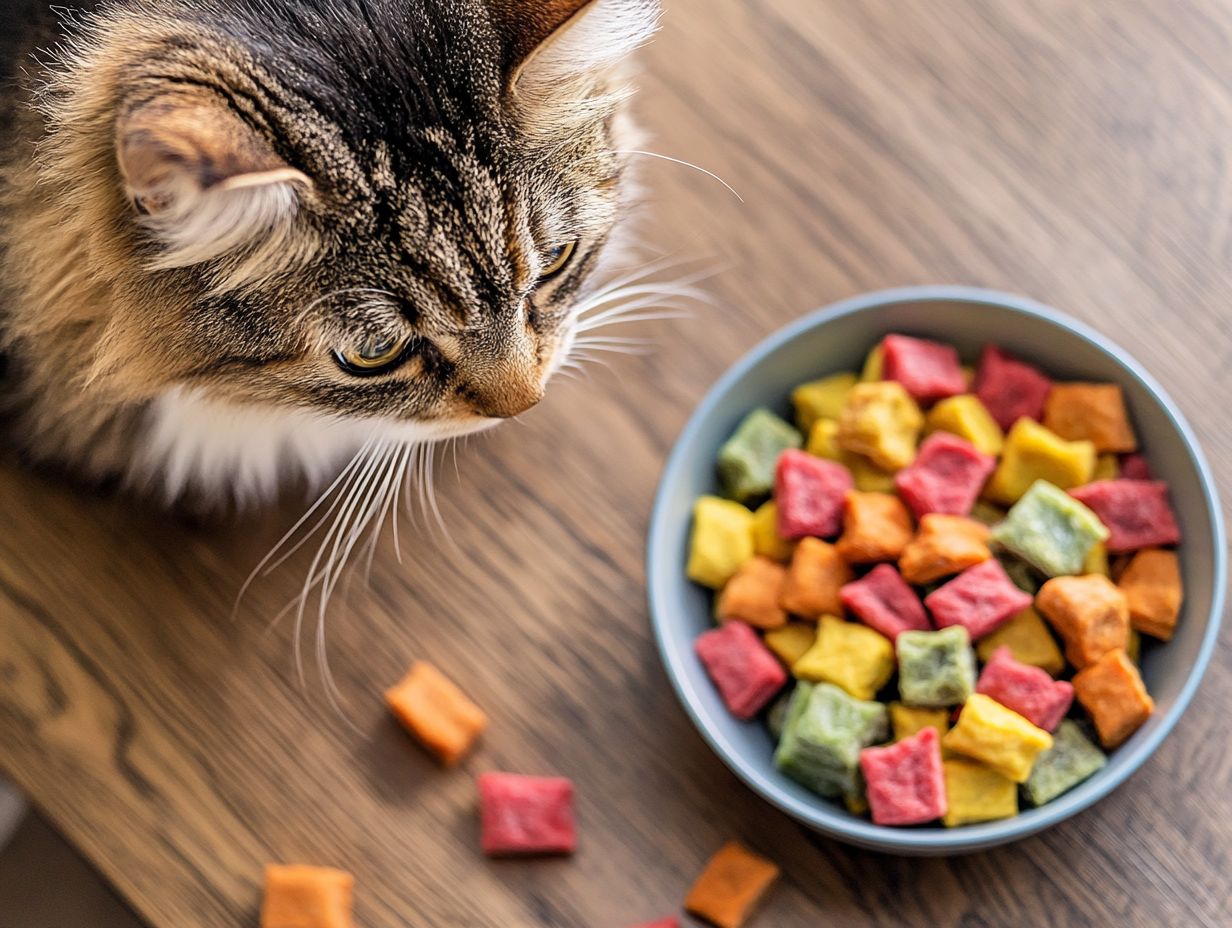Understanding picky eaters, especially with our feline friends, is essential for ensuring they enjoy a balanced diet that meets their nutritional needs. Cats are obligate carnivores and require animal-source proteins for optimal health.
Whether driven by genetics, health issues, or past feeding experiences, some cats can be notoriously selective about their food, showing particular taste preferences.
This article explores the signs of a picky eater and offers practical solutions, including feeding tips and trial-and-error methods, to help coax them into trying new options. Additionally, it is crucial to consult with a veterinarian before making significant dietary changes to ensure nutritional adequacy and address any underlying health issues.
Plus, discover freeze-dried cat foods, like those from Stella & Chewy’s and Wellness CORE, that even the fussiest cats can’t resist! However, it’s important to note that relying solely on freeze-dried foods may lead to incomplete nutrition. Your cat’s next favorite meal might be just a read away.
Key Takeaways:

What Are Picky Eaters?
Picky eaters, particularly in cats, are pets that exhibit specific food preferences, making it challenging for their owners to feed them. These cats may have strong likes and dislikes regarding the types of food they will consume, often refusing certain brands or flavors altogether.
Understanding the unique characteristics and potential causes of these feeding issues is crucial for cat owners, as it enables them to create a more enjoyable feeding experience and ensure their pets receive the necessary nutritional value.
Why Are Some Cats Picky Eaters?
Several factors can contribute to why some cats develop picky eating habits, including genetics, health conditions, and trauma related to past feeding experiences that may alter their food preferences.
Picky eaters often display behaviors linked to their specific diets, which could stem from health issues, allergies, or past trauma, affecting their food choices.
Seeking advice from a veterinarian is essential, as understanding the underlying reasons for picky eating can significantly affect dietary choices and inform owners about potential sensitivities and nutritional needs.
1. Genetics
Genetics significantly influence the eating habits of picky cats, shaping their unique preferences for specific types of food and textures. Certain breeds may have innate preferences for particular tastes or food forms, which can pose challenges for cat owners trying to satisfy their cats’ desires.
This genetic predisposition can create notable dietary differences among various breeds; some may favor richer proteins, while others might prefer certain carbohydrates or fats. For instance, a Siamese cat may prefer wet foods with high moisture content and a smooth texture, while a Maine Coon may be more inclined towards larger kibbles with a meaty flavor.
Understanding these characteristics helps cat owners provide better nutrition for their pets and makes mealtimes more enjoyable, as cats can relish flavors that align with their genetic heritage, turning feeding times into a more fun experience for both the cats and their owners.
2. Health Issues
Health issues such as dental disease or food sensitivities can significantly contribute to a cat’s picky eating habits, often requiring the assistance of a veterinarian for resolution. When cats experience discomfort or pain related to certain foods, they may refuse to eat, potentially leading to additional health problems.
These issues can range from simple oral pain that makes chewing difficult to allergies that cause digestive distress, each affecting their eating behavior in unique ways. A thorough examination by a veterinarian is necessary to identify these specific health issues and recommend appropriate treatments.
It is also crucial to understand a cat’s nutritional needs; while diets can be adjusted to accommodate sensitivities, care must be taken to ensure they are not consuming foods that could worsen their conditions. With the veterinarian’s guidance, pet owners can establish a balanced diet that promotes overall health while catering to their feline friend’s individual preferences.
3. Traumatic Experiences
Trauma related to past feeding experiences can leave lasting effects on a cat’s willingness to try new foods. These experiences may stem from negative associations with specific food types or brands.
Special Dietary Considerations
Different life stages require specific nutritional adjustments, and picky eating can vary by age. Kittens have different protein and calorie needs compared to senior cats, who may require diets that support joint health and digestion.
Consulting with a veterinarian can help ensure that your cat receives appropriate nutrition tailored to their age and health status.
Weight Management
Maintaining a healthy weight is essential for all cats, including picky eaters. Referencing the latest feline obesity guidelines can assist in managing weight, regardless of food preferences.
Common Allergens and Toxic Ingredients
Be cautious of common allergens and toxic ingredients in cat food, such as onions, garlic, and certain grains. Always check food labels to ensure the safety and health of your cat.
Food Safety Tips
Identifying and preventing spoilage is crucial in keeping your cat’s food safe. Ensure proper food storage and handling practices to maintain quality and safety.
Cats are obligate carnivores, meaning they require a diet rich in animal-source proteins to thrive. Traumatic experiences, such as sudden changes in diet or negative associations with specific types of food, can significantly impact a cat’s eating habits, resulting in food refusals and the development of idiosyncratic preferences. These experiences can leave lasting effects on picky eaters, making them even more selective about their diets. A balanced diet is crucial for maintaining their health and preventing nutritional deficiencies.
For instance, a cat that has transitioned to a nutritionally inadequate food may associate the discomfort it experienced with that particular brand and subsequently reject it altogether. Additionally, sudden loud noises during feeding times or negative interactions with new caregivers can lead to anxiety-related aversions. Drastic changes in diet should be avoided; introducing new foods gradually under veterinary guidance is important, especially for sensitive cats.
To assist these sensitive cats, owners can introduce new foods gradually in a calm, controlled environment, utilizing positive reinforcement techniques. Establishing consistent feeding schedules and ensuring a quiet atmosphere can help restore a sense of security, encouraging cats to try and accept a wider variety of foods without anxiety or reluctance.
What Are the Signs of a Picky Eater?
Signs of picky eaters in cats include refusing to eat certain foods, showing aversion to specific textures, and exhibiting increasing selectivity in their choices, influenced by factors like flavor appeal and texture appeal. Changes in energy levels, coat quality, and weight may indicate nutritional deficiencies, emphasizing the importance of a balanced diet rather than just individual preferences.
Many cat owners may wish to identify these signs to better understand their cat’s unique preferences and feeding issues. Recognizing these signs early can assist owners in finding food options that cater to their cat’s particular habits while addressing any potential nutritional gaps.
1. Refusing to Eat Certain Foods

Picky eaters among cats can sometimes refuse certain foods entirely, leading to significant feeding challenges for their owners. Understanding these picky eating habits is crucial, as it allows owners to identify which foods their cats dislike and seek alternative nutritional sources.
When cats reject specific foods, they may develop gaps in their nutritional intake, potentially resulting in health issues as they age. Owners may observe changes in their cat’s energy levels, coat quality, and weight—indicators that their pet is lacking one or more essential nutrients, such as taurine, vital for heart and eye health, as well as other essential vitamins and minerals.
To determine their cat’s food preferences, owners can monitor eating habits and experiment with various textures and flavors. Providing a balanced diet tailored to their cat’s dietary preferences is essential and should include high-quality proteins, vitamins, and minerals to promote overall health. Additionally, cat owners should consult with a veterinarian to create a feeding plan that aligns with their cat’s specific needs and preferences.
2. Only Eating Certain Types of Food
Picky cats often display specific food preferences, such as only eating wet food or exclusively dry food. This behavior highlights the significance of individual food preferences and flavor acceptability in feline picky eating. These preferences can pose challenges for owners trying to provide a varied diet that meets the nutritional needs of their cats.
It is essential for all cat owners to understand the factors influencing the choices of picky eaters, with flavor and texture being major components. Some picky cats gravitate toward foods with richer or creamier flavors, while others prefer crunchy or chewy textures. Additionally, a cat’s previous experiences and physical condition can influence their attraction to certain foods.
To encourage a more balanced diet, owners can mix different textures or flavors and introduce them gradually. Incorporating treats or toppers that the cat enjoys can also facilitate the transition to new food preferences, ultimately improving their well-being without forcing them to eat what they might refuse. Owners should also consider the risks of certain food types, such as raw or homemade diets, and consult with a veterinarian to ensure these diets meet nutritional needs and avoid deficiencies.
3. Losing Weight or Not Gaining Weight
Weight loss or inadequate weight gain in picky eaters is a serious concern and can indicate underlying health issues that require veterinary attention and dietary adjustments. These problems often arise from food refusals and selective eating patterns, which prevent cats from obtaining the necessary nutrition.
Cats that are picky eaters may develop deficiencies in essential vitamins and minerals vital for their overall health. This issue is not trivial; being a picky eater can signal underlying conditions such as dental disease, gastrointestinal disorders, or stress-related issues. Monitoring by a veterinarian is recommended for any underlying health issues.
Additionally, proper food storage and handling are important to prevent spoilage, ensuring the safety of the food provided to cats. While ethical and sustainability concerns are valid, the health and nutritional needs of cats should always take priority in dietary decisions.
A veterinarian should investigate these potential health problems and recommend dietary changes to ensure the cat maintains a balanced and healthy diet, as well as a proper weight. Consulting a veterinarian is crucial not only for addressing picky eating but also for ensuring compliance with the latest veterinary nutrition standards.
How Can You Help a Picky Eater?
Assisting a selective eater involves several strategies, including consulting a veterinarian to rule out any medical issues and exploring various food options that cater to their specific preferences, considering factors like ingredient sourcing and ethical products. As obligate carnivores, cats require animal-source proteins to meet their dietary needs, highlighting the importance of high-quality protein sources in their diet.
Implementing appropriate feeding tips and conducting food trials can enhance mealtime enjoyment and encourage a more varied diet. It’s essential to make gradual dietary changes to avoid gastrointestinal upset, while constant observation is necessary when introducing new foods.
1. Consult with a Veterinarian
Consulting a veterinarian is an essential step when addressing selective eating behaviors, as they can determine if any underlying health problems, dental issues, or food sensitivities are contributing to the behavior. This veterinarian consultation ensures that any medical issues are identified and addressed, while also providing recommendations for dietary changes that are medically appropriate and cater to specific food preferences.
In many cases, underlying medical conditions such as dental problems or gastrointestinal disorders can lead to a cat’s selective eating behaviors. Additionally, allergies or intolerances to specific ingredients may develop, making expert advice crucial. Veterinarians can conduct thorough examinations and recommend diagnostic tests to identify these health issues, including food analysis and food trials.
Once these issues are identified, veterinarians can collaborate with pet owners to create individualized feeding plans that cater to their cat’s taste preferences while also satisfying their health needs, ensuring that selective eating does not compromise proper nutrition.
2. Offer a Variety of Foods
Offering a variety of foods to selective cats is an effective strategy to entice them to eat. This approach introduces different flavor combinations, caters to their texture preferences, and helps you discover their unique preferences and food choices. By providing a range of options, you can identify what your cat enjoys most while ensuring they receive a balanced diet, including food shapes and textures that appeal to them.
One crucial aspect of introducing variety is to do so gradually, adding one new option alongside their usual wet or dry food. Starting slowly can reduce anxiety and allow cats to explore different tastes without feeling overwhelmed. However, sudden diet changes can pose risks, including allergic reactions or digestive issues. It is advisable for pet owners to consult their veterinarian about introducing new foods and to closely monitor their cat’s reactions to new options.
You may notice that they favor certain consistencies, such as crunchy or creamy, which can guide your future choices. Diverse mealtime options create opportunities for engagement and help develop healthy eating habits, fostering a more adventurous palate in the long run. This approach also enhances mealtime excitement and texture appeal.
3. Try Freeze-Dried Cat Foods
Freeze-dried cat foods are an excellent option for selective eaters, as they tend to be nutritionally dense while remaining palatable for cats with specific taste preferences and feeding challenges. These foods can prove beneficial, even for the most discerning cats. One significant advantage of freeze-dried options is that they are often made with real meat, fish, or poultry, which are essential for cats, as they require these proteins and nutrients. This can be particularly helpful for cats with specific dietary needs, food sensitivities, or unique preferences.
When introducing a freeze-dried diet to a selective cat, it is advisable to start slowly. Begin by adding a small amount of the new food to their regular diet and gradually increase the portion until they become accustomed to it. Careful observation is essential; take note of any positive or negative reactions to the new food. You can adjust the amounts and combinations to find the right mix that the cat enjoys while ensuring a healthy diet.
It is also important to ensure the safety of freeze-dried options by adhering to proper storage and handling practices to prevent spoilage and foodborne illnesses.
What Are Some Freeze-Dried Cat Foods That Selective Eaters Love?

The following freeze-dried cat foods are popular choices for catering to selective eaters:
- Smalls
- Stella & Chewy’s
- Nulo
- Tiki Cat
These brands provide a well-balanced selection of flavors and textures that are sure to appeal to discerning feline palates. It is recommended that pet owners check ingredient lists for allergens or harmful additives and ensure all mentioned brands comply with AAFCO standards.
Special Dietary Considerations
For cats with health conditions such as kidney disease or diabetes, it is vital to follow a veterinarian’s guidance when managing their dietary needs. Special dietary formulations may be required to accommodate these conditions, emphasizing the importance of professional advice.
Conclusion
In summary, the importance of consulting a veterinarian cannot be overstated when addressing selective eating behaviors in cats. Ensuring balanced nutrition and carefully observing dietary changes are essential components of their care. Additionally, proper storage of cat food and checking for spoilage is critical for maintaining food safety and health.
1. Stella & Chewy’s Freeze-Dried Raw Dinner Morsels
Stella & Chewy’s Freeze-Dried Raw Dinner Morsels provide high-quality animal protein that supports a natural raw diet, essential for the health of obligate carnivores like cats. These morsels have a texture that encourages even the fussiest eaters to enjoy them.
The carefully formulated ingredients offer a rich source of essential vitamins and minerals necessary for good health and vitality. Customers have noted that their picky cats readily consume this freeze-dried food compared to other options. However, it’s crucial to consult a veterinarian before introducing these foods, especially for cats with specific health conditions like kidney disease or diabetes.
Moreover, the ease of preparing a fresh meal by simply adding water for rehydration offers a significant advantage in providing a nutritious and satisfying dining experience. It’s important to remember that freeze-dried foods should not replace a complete diet, and pet owners should ensure compliance with AAFCO and WSAVA guidelines for balanced nutrition.
2. Primal Pet Foods Freeze-Dried Nuggets
Primal Pet Foods Freeze-Dried Nuggets cater to picky eaters, providing both nutrition and an optimal feeding solution. With a high moisture content and healthy fats, these nuggets are designed for finicky felines.
These nuggets consist of a balanced mix of premium proteins, vitamins, and minerals to meet the dietary needs of selective pets. Reviews highlight the enthusiasm of cats at mealtime, along with observable health benefits such as increased energy levels. Regular veterinary check-ups are recommended to monitor for any potential nutritional deficiencies.
Preparation involves simply rehydrating them with water, making it convenient for pet owners. Many have reported a decrease in mealtime stress, as their formerly finicky cats now clean their bowls every time. Proper storage and handling of freeze-dried foods are essential to prevent spoilage, and pet owners should be vigilant about identifying signs of spoilage.
3. Orijen Freeze-Dried Cat Treats
Orijen Freeze-Dried Cat Treats are an excellent choice for picky eaters, thanks to their high-quality ingredients and a variety of flavors that cater to the diverse tastes of felines. These nutritious snacks can effectively entice finicky cats during mealtimes.
Made with fresh, regionally sourced ingredients, they are packed with protein and essential nutrients. Cat owners report strong appeal from flavors like wild boar and duck. However, as with all freeze-dried foods, it is vital to ensure that they are part of a nutritionally balanced diet, adhering to established dietary guidelines.
Additionally, many reviews highlight improvements in cats’ energy levels and overall health, making Orijen one of the most trusted brands for picky eaters. Discussing ethical and sustainability concerns with a veterinarian can help reassure owners that their choices prioritize their cat’s health.
How Can You Incorporate Freeze-Dried Cat Foods into Your Cat’s Diet?
Incorporate freeze-dried cat foods into your cat’s diet by offering a mix of wet and dry food. This combination not only adds variety and flavor but also enhances hydration and nutrition, ensuring your cat enjoys a well-rounded diet.
1. Mix with Wet or Dry Food
Mixing freeze-dried cat food with wet or dry food introduces new flavors and textures to a cat’s diet, which can be particularly beneficial for picky eaters. This method allows for trial-and-error with different combinations that may appeal to even the most selective cats.
By gradually incorporating these freeze-dried options into regular meals, cat owners can create enticing dishes that boost appetite while providing essential nutrients. Start with small portions and monitor the cat’s reaction to the new mixture. Any changes in behavior or digestion can serve as valuable indicators for future dietary choices.
This not only offers varied mealtime stimulation but also ensures balanced nutrition and health, as combining these foods can enhance hydration and flavor, significantly improving your pet’s dietary experience.
2. Use as a Treat or Topping
Freeze-dried cat foods as treats or toppings can significantly enhance the excitement of mealtimes for cats and cater to picky eaters. These products allow caregivers to introduce new flavors creatively without major dietary changes.
Simply sprinkle them on top of standard meals to boost flavor and aroma—an important factor for finicky eaters. Caregivers can experiment with various combinations to make mealtimes more engaging, all while adhering to portion guidelines to manage their cat’s weight effectively.
Regular veterinary check-ups and consultations about special dietary considerations for different life stages (kittens, senior cats, pregnant or nursing cats) are recommended to ensure a comprehensive overview of nutritional needs.
For instance, adding a sprinkle of freeze-dried chicken or fish can enhance the flavor of a meal. With these additives, caregivers can observe their cats’ reactions and discover the ideal flavors that gradually introduce their cat’s palate to new tastes, ultimately finding the right combinations that satisfy each cat’s unique preferences.
3. Transition to a Freeze-Dried Cat Food Diet

Transitioning to a freeze-dried cat food diet requires careful planning and a gradual introduction to ensure that picky eaters adapt comfortably while maintaining their nutritional value and hydration. To facilitate this transition, cat owners should follow effective feeding tips. It is recommended to consult a veterinarian before making significant changes to your cat’s diet to ensure it meets their specific nutritional needs.
- The first step is to mix a small amount of freeze-dried food into the cat’s regular diet, allowing them to gradually acclimate to the new texture and taste. This helps focus on the nutritional benefits of the new diet.
- It is crucial to closely monitor their response during this period for any signs of digestive upset, food rejection, or refusal to eat. Consulting with veterinarians can provide additional guidance.
- Over the course of about a week, the proportion of freeze-dried food should be gradually increased while decreasing the conventional diet, ensuring proper nutritional value is maintained.
- This slow transition minimizes the risk of issues and maximizes the benefits of the high protein content and essential nutrients, such as probiotics and healthy fats found in freeze-dried food. Freeze-dried food should ideally be rehydrated before serving to support hydration.
- Additionally, serving the mixed food with warm water can further enhance hydration, supporting hydration support and overall health.
Frequently Asked Questions
What makes freeze-dried cat food different from traditional cat food and other food options?
Freeze-dried cat food is made by removing all moisture content from the food, preserving its nutritional value and flavor appeal, while traditional cat food, which primarily refers to kibble or canned food, often contains fillers, food additives, and artificial ingredients that may not be as protein-rich.
Can picky eaters and picky cats really benefit from freeze-dried cat food?
Yes, picky eaters and picky cats can benefit from freeze-dried cat food because it is often made with high-quality and natural ingredients that are more appealing to cats. This appeals to their texture appeal and taste preferences.
Are there specific ingredients in freeze-dried cat food that cater to cats’ unique preferences?
Many freeze-dried cat foods include ingredients like chicken liver, salmon, and other meats that are highly palatable to cats and hard for them to resist. Brands such as Smalls, Tiki Cat, and Nulo offer such flavor combinations.
Can freeze-dried cat food help with a cat’s digestion and food sensitivities?
Yes, freeze-dried cat food often contains probiotics and easily digestible proteins that can improve a cat’s digestion and overall gut health, addressing food sensitivities effectively.
Is freeze-dried cat food more expensive than traditional cat food or wet food?
Frequently, freeze-dried cat food can be more expensive than traditional cat food or wet food due to its high-quality ingredients, ingredient sourcing, and production process. However, the health benefits should be weighed against potential health benefits and veterinary advice on diet suitability.
Can all cats eat freeze-dried cat food, or is it only for picky eaters and cats with specific dietary needs?
Freeze-dried cat food can be beneficial for all cats, not just picky eaters and those with specific dietary needs. Its nutrient-dense and easily digestible nature makes it a good option for cats of all ages and dietary needs. Consulting a veterinarian is recommended for specific health problems. It’s also important to check ingredient labels to avoid allergens or harmful additives in freeze-dried foods, and to be aware of the risk of bacterial contamination in raw diets, emphasizing proper food handling.